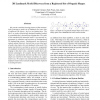Free Online Productivity Tools
i2Speak
i2Symbol
i2OCR
iTex2Img
iWeb2Print
iWeb2Shot
i2Type
iPdf2Split
iPdf2Merge
i2Bopomofo
i2Arabic
i2Style
i2Image
i2PDF
iLatex2Rtf
Sci2ools
126
click to vote
CVPR
2012
IEEE
2012
IEEE
3D landmark model discovery from a registered set of organic shapes
We present a machine learning framework that automatically generates a model set of landmarks for some class of registered 3D objects: here we use human faces. The aim is to replace heuristically-designed landmark models by something that is learned from training data. The value of this automatically generated model is an expected improvement in robustness and precision of learning-based 3D landmarking systems. Simultaneously, our framework outputs optimal detectors, derived from a prescribed pool of surface descriptors, for each landmark in the model. The model and detectors can then be used as key components of a landmark-localization system for the set of meshes belonging to that object class. Automatic models have some intrinsic advantages; for example, the fact that repetitive shapes are automatically detected and that local surface shapes are ordered by their degree of saliency in a quantitative way. We compare our automatically generated face landmark model with a manually desi...
Related Content
| Added | 28 Sep 2012 |
| Updated | 28 Sep 2012 |
| Type | Journal |
| Year | 2012 |
| Where | CVPR |
| Authors | Clement Creusot, Nick Pears, Jim Austin |
Comments (0)

